NUSearch Developer Guide
Table of Contents
- Table of Contents
- Acknowledgement
- Setting up, getting started
- Design
- Implementation
- Add feature
- List feature
- Delete feature
- Favourite feature
- Unfavourite feature
- Favourite List feature
- Search feature
- Autocomplete feature
- [Proposed] Undo/redo feature
- [Proposed] Edit feature
- Documentation, logging, testing, configuration, dev-ops
- Appendix: Requirements
- Appendix: Instructions for manual testing
Acknowledgements
This project is based on the AddressBook-Level3 project created by the SE-EDU initiative.
Setting up, getting started
Refer to the guide Setting up and getting started.
Design
Architecture

The Architecture Diagram given above explains the high-level design of the App.
Given below is a quick overview of main components and how they interact with each other.
Main components of the architecture
Main (consisting of classes Main and MainApp) is in charge of the app launch and shut down.
- At app launch, it initializes the other components in the correct sequence, and connects them up with each other.
- At shut down, it shuts down the other components and invokes cleanup methods where necessary.
The bulk of the app's work is done by the following four components:
UI: The UI of the App.Logic: The command executor.Model: Holds the data of the App in memory.Storage: Reads data from, and writes data to, the hard disk.
Commons represents a collection of classes used by multiple other components.
How the architecture components interact with each other
The Sequence Diagram below shows how the components interact with each other for the scenario where the user issues the command delete 1.

Each of the four main components (also shown in the diagram above),
- defines its API in an
interfacewith the same name as the Component. - implements its functionality using a concrete
{Component Name}Managerclass (which follows the corresponding APIinterfacementioned in the previous point.
For example, the Logic component defines its API in the Logic.java interface and implements its functionality using the LogicManager.java class which follows the Logic interface. Other components interact with a given component through its interface rather than the concrete class (reason: to prevent outside component's being coupled to the implementation of a component), as illustrated in the (partial) class diagram below.

The sections below give more details of each component.
UI component
The API of this component is specified in Ui.java

The UI consists of a MainWindow that is made up of parts e.g.CommandBox, ResultDisplay, PersonListPanel, StatusBarFooter etc. All these, including the MainWindow, inherit from the abstract UiPart class which captures the commonalities between classes that represent parts of the visible GUI.
The UI component uses the JavaFx UI framework. The layout of these UI parts are defined in matching .fxml files that are in the src/main/resources/view folder. For example, the layout of the MainWindow is specified in MainWindow.fxml
The UI component,
- executes user commands using the
Logiccomponent. - listens for changes to
Modeldata so that the UI can be updated with the modified data. - keeps a reference to the
Logiccomponent, because theUIrelies on theLogicto execute commands. - depends on some classes in the
Modelcomponent, as it displaysPersonobject residing in theModel.
Logic component
API : Logic.java
Here's a (partial) class diagram of the Logic component:

The sequence diagram below illustrates the interactions within the Logic component, taking execute("delete 1") API call as an example.

Note: The lifeline for DeleteCommandParser should end at the destroy marker (X) but due to a limitation of PlantUML, the lifeline reaches the end of diagram.
How the Logic component works:
- When
Logicis called upon to execute a command, it is passed to anAddressBookParserobject which in turn creates a parser that matches the command (e.g.,DeleteCommandParser) and uses it to parse the command. - This results in a
Commandobject (more precisely, an object of one of its subclasses e.g.,DeleteCommand) which is executed by theLogicManager. - The command can communicate with the
Modelwhen it is executed (e.g. to delete a person). - The result of the command execution is encapsulated as a
CommandResultobject which is returned back fromLogic.
Here are the other classes in Logic (omitted from the class diagram above) that are used for parsing a user command:

How the parsing works:
- When called upon to parse a user command, the
AddressBookParserclass creates anXYZCommandParser(XYZis a placeholder for the specific command name e.g.,AddCommandParser) which uses the other classes shown above to parse the user command and create aXYZCommandobject (e.g.,AddCommand) which theAddressBookParserreturns back as aCommandobject. - All
XYZCommandParserclasses (e.g.,AddCommandParser,DeleteCommandParser, ...) inherit from theParserinterface so that they can be treated similarly where possible e.g, during testing.
Model component
API : Model.java

The Model component,
- stores the address book data i.e., all
Personobjects (which are contained in aUniquePersonListobject). - stores the currently 'selected'
Personobjects (e.g., results of a search query) as a separate filtered list which is exposed to outsiders as an unmodifiableObservableList<Person>that can be 'observed' e.g. the UI can be bound to this list so that the UI automatically updates when the data in the list change. - stores a
UserPrefobject that represents the user’s preferences. This is exposed to the outside as aReadOnlyUserPrefobjects. - does not depend on any of the other three components (as the
Modelrepresents data entities of the domain, they should make sense on their own without depending on other components)
Note: An alternative (arguably, a more OOP) model is given below.

Storage component
API : Storage.java

The Storage component,
- can save both address book data and user preference data in JSON format, and read them back into corresponding objects.
- inherits from both
AddressBookStorageandUserPrefStorage, which means it can be treated as either one (if only the functionality of only one is needed). - depends on some classes in the
Modelcomponent (because theStoragecomponent's job is to save/retrieve objects that belong to theModel)
Common classes
Classes used by multiple components are in the seedu.addressbook.commons package.
Implementation
This section describes some noteworthy details on how certain features are implemented.
Add Feature
Implementation details
The add feature allows user to add up to five different details of a person, including the name, role the person,
contact details, the course the person is taking, as well as the respective tutorial classes.
Implementation:
- When adding a profile, the only compulsory field that user has to include is the
namefield. - All the other fields
role,contactandcourseare optional. - The fields can be added in any order.
- Users can have more than one input for each of the optional field.
- When adding a
course, users can also choose to include or not to include the tutorial classes of the course.
Design Considerations
- User Expectations: Users have a common expectation that their favorite persons should be identifiable in the UI. Hence, a role tag is being added for different roles.
- Ease of Use: Having only one compulsory field when adding a person makes it faster and easier for users to add someone into the list, instead of having to type include every single field, some of which might be unknown to the users.
List Feature
Implementation details
the listfeature allows user to get the information (name, role,
contact details, courses, tutorial classes) of all the people stored.
Implementation:
- the list feature is executed using the
listcommand
Delete feature
Implementation:
The delete feature allows the user to delete a person that they don't want to view anymore or a person with fields that have to be edited (such that they can add the person with the same name but with edited fields after deleting the original). It identifies the person based on its displayed index in the person list.
DeleteCommandParser#parse(String args)-- Parses the user input and creates aDeleteCommandobject.DeleteCommand#execute(Model model)-- Executes the command to delete a person identified by the index in the person list and returns aCommandResultobject.
Given below is an example usage scenario and how the delete feature behaves at each step:
- The user wants to delete a person that they want to view on a frequent basis.
- The user executes
deletecommand with the person index. For instance,delete 1will favourite the person at index 1. - The command is parsed in
AddressBookParser.DeleteCommandParserobject then is created. DeleteCommandParserobject parses the user input and creates anDeleteCommandobject with the givenINDEXwhich represents the index of thePersonto be deleted in the person list.- The
DeleteCommand#execute(Model model)callsModel::getFilteredPersonListand gets the specifiedPersonfrom the filtered person list using the index. - The
executemethod then calls thedeletePersonmethod in theModelManagerwith the specifiedPersonto be deleted. - The result of the
executemethod is returned as aCommandResultobject, which is returned back to theLogicManager.
The following sequence diagram shows how the delete operation works:
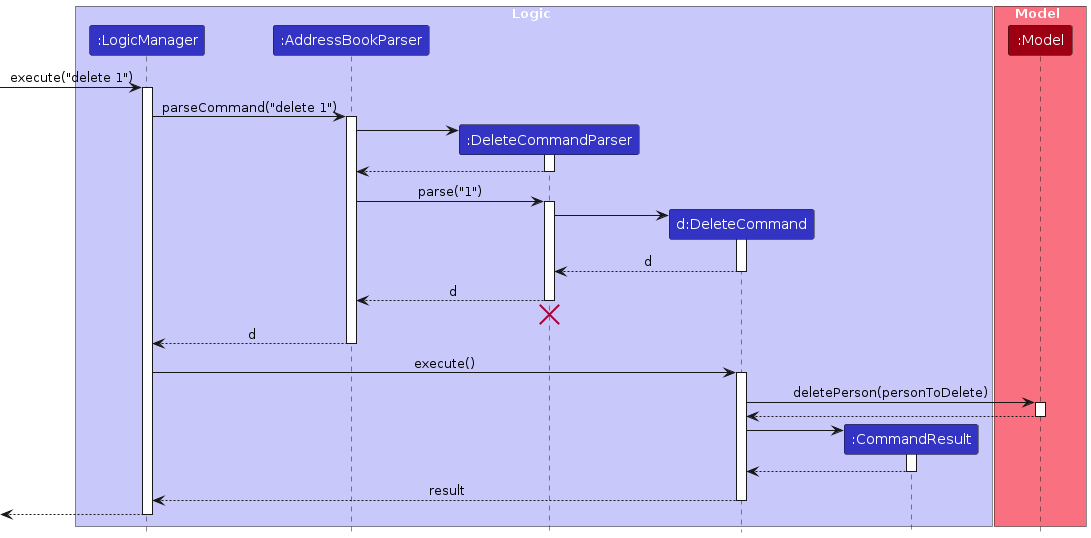
Note
DeleteCommandParser should end at the destroy marker [X].
Favourite feature
Implementation:
The favourite feature allows the user to favourite persons that they want to view on a frequent basis. It identifies the person based on its displayed index in the person list.
FavouriteCommandParser#parse(String args)-- Parses the user input and creates aFavouriteCommandobject.FavouriteCommand#execute(Model model)-- Executes the command to favourite a person identified by the index in the person list and returns aCommandResultobject.
Given below is an example usage scenario and how the favourite feature behaves at each step:
- The user wants to favourite a person that they want to view on a frequent basis.
- The user executes
favcommand with the person index. For instance,fav 1will favourite the person at index 1. - The command is parsed in
AddressBookParser.FavouriteCommandParserobject then is created. FavouriteCommandParserobject parses the user input and creates anFavouriteCommandobject with the givenINDEXwhich represents the index of thePersonto be favourited in the person list.- The
FavouriteCommand#execute(Model model)callsModel::getFilteredPersonListand gets the specifiedPersonfrom the filtered person list using the index. - The
executemethod then calls thefavouritePersonmethod in theModelManagerwith the specifiedPersonto be favourited. - After that, the
executemethod will call thesetPersonmethod in theModelManagerto set the currentPersonto a newPersonwith the same fields as the currentPerson, except that theisFavouritefield is set totrue. - The result of the
executemethod is returned as aCommandResultobject, which is returned back to theLogicManager.
The following sequence diagram shows how the unfavourite operation works:

Note
FavouriteCommandParser should end at the destroy marker [X].
Design considerations
- User Expectations: Users have a common expectation that their favorite persons should be identifiable in the UI. Hence, a yellow tag is added to the UI to indicate that the person is a favourite.
Unfavourite feature
Implementation:
The unfavourite feature allows the user to unfavourite favourited persons that they do not want to view on a frequent basis anymore. It identifies the person based on its displayed index in the person list.
UnfavouriteCommandParser#parse(String args)-- Parses the user input and creates aUnfavouriteCommandobject.UnfavouriteCommand#execute(Model model)-- Executes the command to unfavourite a person identified by the index in the person list and returns aCommandResultobject.
Given below is an example usage scenario and how the unfavourite feature behaves at each step:
- The user wants to unfavourite a person that they do not want to view on a frequent basis anymore.
- The user executes
unfavcommand with the person index. For instance,unfav 1will unfavourite the person at index 1. - The command is parsed in
AddressBookParser.UnfavouriteCommandParserobject then is created. UnfavouriteCommandParserobject parses the user input and creates anUnfavouriteCommandobject with the givenINDEXwhich represents the index of thePersonto be unfavourited in the person list.- The
UnfavouriteCommand#execute(Model model)callsModel::getFilteredPersonListand gets the specifiedPersonfrom the filtered person list using the index. - The
executemethod then calls theunfavouritePersonmethod in theModelManagerwith the specifiedPersonto be unfavourited. - After that, the
executemethod will call thesetPersonmethod in theModelManagerto set the currentPersonto a newPersonwith the same fields as the currentPerson, except that theisFavouritefield is set tofalse. - The result of the
executemethod is returned as aCommandResultobject, which is returned back to theLogicManager.
The following sequence diagram shows how the unfavourite operation works:

Note
UnfavouriteCommandParser should end at the destroy marker [X].
Favourite List feature
Implementation Details & Philosophy
High Level Description:
The favourite list feature is executed using the favlist command.
FavList Command
A FavListCommand Java class that extends the parent Command class will be created. This base class
will represent the favlist command
Command Word
A constant COMMAND_WORD = "favlist" is instantiated.
Usage Message
A usage message constant MESSAGE_USAGE will be created to explain to the users how to interact and
use the favlist command
Integration with Model
To ensure that the FavListCommand class interacts with the application's model
to perform actions related to the favorite list. This will be done through the
model.updateFilteredPersonList(predicate) method.
In essence, the sequence of events is illustrated by the following activity diagram:
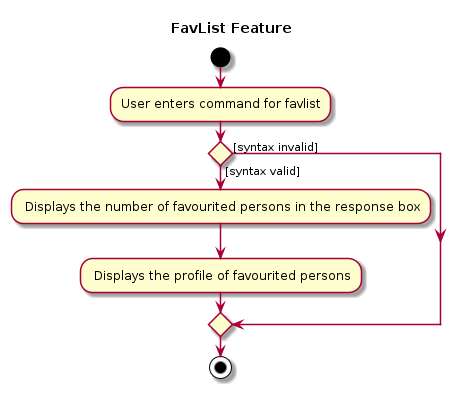
Design considerations
- User Expectations:
Users have a common expectation that their favorited people should be accessible
and manageable in a straightforward manner. Hence, this is fulfilled using a simple and intuitive
favlistcommand.
Search feature
Implementation Details & Philosophy
Description:
The search feature contains 4 different sub commands namely : search, searchrole,
searchcourse, searchtutorial .
searchallows the user to search for a person through their namesearchroleallows the user to search for a list of people with the same rolesearchcourseallows the user to search for a list of people taking a particular coursesearchtutorialallows the user to search for a list of people taking a particular tutorial
Implementation:
search
A `search` class has a `NameContainsKeywordPredicate` field that describes the search criteria and filters the list of persons.`NameContainsKeywordPredicate` implements the Predicate interface for Person object. It is used to filter a collection of Person objects based on whether their names contain a certain keyword.
In essence, the sequence of events is illustrated by the following activity diagram:
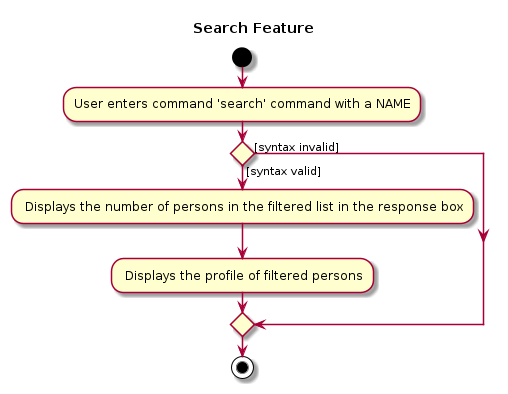
searchrole
A `searchrole` class has a `RoleContainsKeywordPredicate` field that describes the search criteria and filters the list of persons. `RoleContainsKeywordPredicate` implements the Predicate interface for Person object. It is used to filter a collection of Person objects based on whether their role contain a certain keyword.
In essence, the sequence of events is illustrated by the following activity diagram:
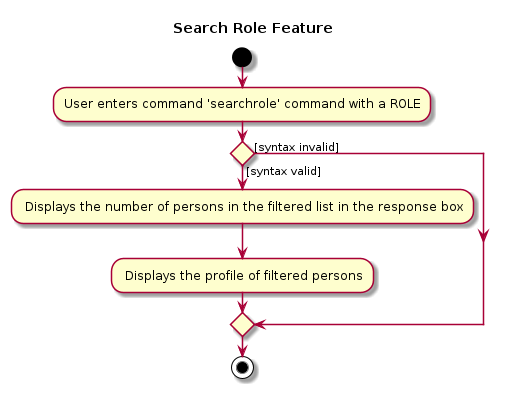
searchcourse
A `searchcourse` class has a `CourseContainsKeywordPredicate` field that describes the search criteria and filters the list of persons. `CourseContainsKeywordPredicate` implements the Predicate interface for Person object. It is used to filter a collection of Person objects based on whether their courses contain a certain keyword.
In essence, the sequence of events is illustrated by the following activity diagram:
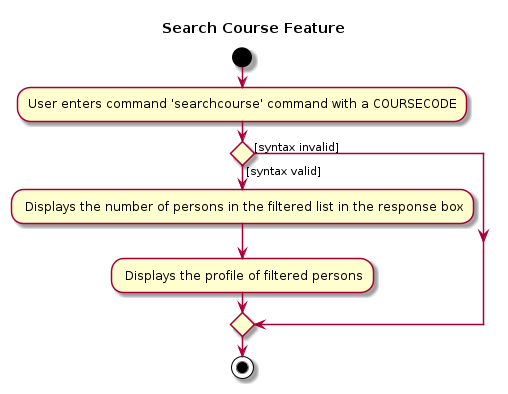
searchtutorial
A `searchtutorial` class has a `TutorialContainsKeywordPredicate` field that describes the search criteria and filters the list of persons. `TutorialContainsKeywordPredicate` implements the Predicate interface for Person object. It is used to filter a collection of Person objects based on whether their tutorials contain a certain keyword.
In essence, the sequence of events is illustrated by the following activity diagram:

Design considerations
-
1. Clarity and Ease of Use
Having distinct search commands for different purposes instead of a single search command that searches all four makes it clear to the user what each command is used for. Hence, this will make the interface more user-friendly as it reduces the likelihood of the users getting confused about the commands.
2. ScalabilityIf the search feature were to be expanded or modified in the future, it would be easier to add or change specific commands and their functions without affecting the whole search system.
Additionally, if the search feature was to modified to allow multiple searches in a single command, If a single search command was used, users may need to use complex syntax to specify what they are searching for. Hence, having 4 different search commands will reduce ambiguity and hence make it more scalable.
3. Improved Error HandlingWith a specific search command for each search, it is easier to give specific and targeted error messages. For a single search command that handles multiple types of searches, providing relevant feedback can be more challenging. Hence, the error messages for a single search command might not be specific, making the application less user-friendly.
Autocomplete Feature
Implementation
The autocomplete feature relies on the Map from Command Words to CheckedFunction in the AddressBookParser.java named wordToCommandMap. On instantiation, this Map is populated with each Command Word as keys, and their respective values as lambda CheckedFunctions taking in the String userInput as arguments and returning a parsed version of their respective function. For example, a short excerpt is shown below;
/**
* Initialize the word to command map. Remember each command word maps to a lambda function
* that will return the parsed Command object. This command object will then be executed.
*/
public AddressBookParser() {
// Command taking in arguments
wordToCommandMap.put(AddCommand.COMMAND_WORD, (arguments) -> new AddCommandParser().parse(arguments));
// Command taking in no arguments; no need to parse via parser
wordToCommandMap.put(ClearCommand.COMMAND_WORD, (arguments) -> new ClearCommand());
// ...
}
Once all the command words are stored in the map, the autocomplete feature will, on key pressed in the command box, check for any command that starts with the String input supplied by the user, and iterate through them one by one. In essence, the sequence of events is illustrated by the following activity diagram:

Design Considerations
- Performance and Scalability:
In order for autocomplete to be used with many commands, a
HashMapimplementation was chosen forAddressBookParser's command word storage data structure as lookup for command words can be done in approximatelyO(1)time. - Consistency: To maintain consistency with users' expectations of how Autocomplete features work, the exact mechanics (ie pressing Tab to cycle through command suggestions) are inspired by some traditional terminals' command autocomplete features, which are similar (for instance, Powershell's default autocomplete works similarly). Thus, users do not have to learn a new mental model for how they would expect the autocomplete to function.
[Proposed] Undo/redo feature
Proposed Implementation
The proposed undo/redo mechanism is facilitated by VersionedAddressBook. It extends AddressBook with an undo/redo history, stored internally as an addressBookStateList and currentStatePointer. Additionally, it implements the following operations:
VersionedAddressBook#commit()— Saves the current address book state in its history.VersionedAddressBook#undo()— Restores the previous address book state from its history.VersionedAddressBook#redo()— Restores a previously undone address book state from its history.
These operations are exposed in the Model interface as Model#commitAddressBook(), Model#undoAddressBook() and Model#redoAddressBook() respectively.
Given below is an example usage scenario and how the undo/redo mechanism behaves at each step.
Step 1. The user launches the application for the first time. The VersionedAddressBook will be initialized with the initial address book state, and the currentStatePointer pointing to that single address book state.

Step 2. The user executes delete 5 command to delete the 5th person in the address book. The delete command calls Model#commitAddressBook(), causing the modified state of the address book after the delete 5 command executes to be saved in the addressBookStateList, and the currentStatePointer is shifted to the newly inserted address book state.

Step 3. The user executes add --name David … to add a new person. The add command also calls Model#commitAddressBook(), causing another modified address book state to be saved into the addressBookStateList.

Note: If a command fails its execution, it will not call Model#commitAddressBook(), so the address book state will not be saved into the addressBookStateList.
Step 4. The user now decides that adding the person was a mistake, and decides to undo that action by executing the undo command. The undo command will call Model#undoAddressBook(), which will shift the currentStatePointer once to the left, pointing it to the previous address book state, and restores the address book to that state.

Note: If the currentStatePointer is at index 0, pointing to the initial AddressBook state, then there are no previous AddressBook states to restore. The undo command uses Model#canUndoAddressBook() to check if this is the case. If so, it will return an error to the user rather
than attempting to perform the undo.
The following sequence diagram shows how the undo operation works:

Note: The lifeline for UndoCommand should end at the destroy marker (X) but due to a limitation of PlantUML, the lifeline reaches the end of diagram.
The redo command does the opposite — it calls Model#redoAddressBook(), which shifts the currentStatePointer once to the right, pointing to the previously undone state, and restores the address book to that state.
Note: If the currentStatePointer is at index addressBookStateList.size() - 1, pointing to the latest address book state, then there are no undone AddressBook states to restore. The redo command uses Model#canRedoAddressBook() to check if this is the case. If so, it will return an error to the user rather than attempting to perform the redo.
Step 5. The user then decides to execute the command list. Commands that do not modify the address book, such as list, will usually not call Model#commitAddressBook(), Model#undoAddressBook() or Model#redoAddressBook(). Thus, the addressBookStateList remains unchanged.

Step 6. The user executes clear, which calls Model#commitAddressBook(). Since the currentStatePointer is not pointing at the end of the addressBookStateList, all address book states after the currentStatePointer will be purged. Reason: It no longer makes sense to redo the add n/David … command. This is the behavior that most modern desktop applications follow.

The following activity diagram summarizes what happens when a user executes a new command:

Design considerations:
Aspect: How undo & redo executes:
Alternative 1 (current choice): Saves the entire address book.
- Pros: Easy to implement.
- Cons: May have performance issues in terms of memory usage.
Alternative 2: Individual command knows how to undo/redo by itself.
- Pros: Will use less memory (e.g. for
delete, just save the person being deleted). - Cons: We must ensure that the implementation of each individual command are correct.
- Pros: Will use less memory (e.g. for
{more aspects and alternatives to be added}
[Proposed] Edit feature
Proposed Implementation
The edit feature allows users to edit specific fields in a person they want to edit. It identifies the person based on its displayed index in the person list.
EditCommandParser#parse(String args)-- Parses the user input and creates aEditCommandobject.EditCommand#execute(Model model)-- Executes the command to edit a person identified by the index in the person list and returns aCommandResultobject.
Given below is an example usage scenario and how the edit feature behaves at each step.
- The user wants to edit some fields that may be typed wrongly in the person fields.
- The user executes
editcommand with the person index and the specifiers of the attribute to be edited. For instance,edit 1 --name new namewill edit the name of the person at index 1 tonew name. - The command is parsed in
AddressBookParser.EditCommandParserobject is created, which creates anEditPersonDescriptorobject. ThisEditPersonDescriptorobject contains the new fields which is to be in the new editedPerson. - An
EditCommandobject is then constructed with thisEditPersonDescriptorobject and the index of the person to be edited. - The
EditCommandobject gets thePersonto be edited from the filtered person list using the index. EditCommandobject then creates an editedPersonfrom the specifiedPersonand theEditPersonDescriptorobject.EditCommandobject then calls thesetPersonmethod inModelManagerwith the editedPerson. This sets thePersonspecified by the index in the model to be that editedPerson.EditCommandobject updates the person list to then display the editedPersonin the UI.
The following sequence diagram illustrates the above steps for editing a Person.
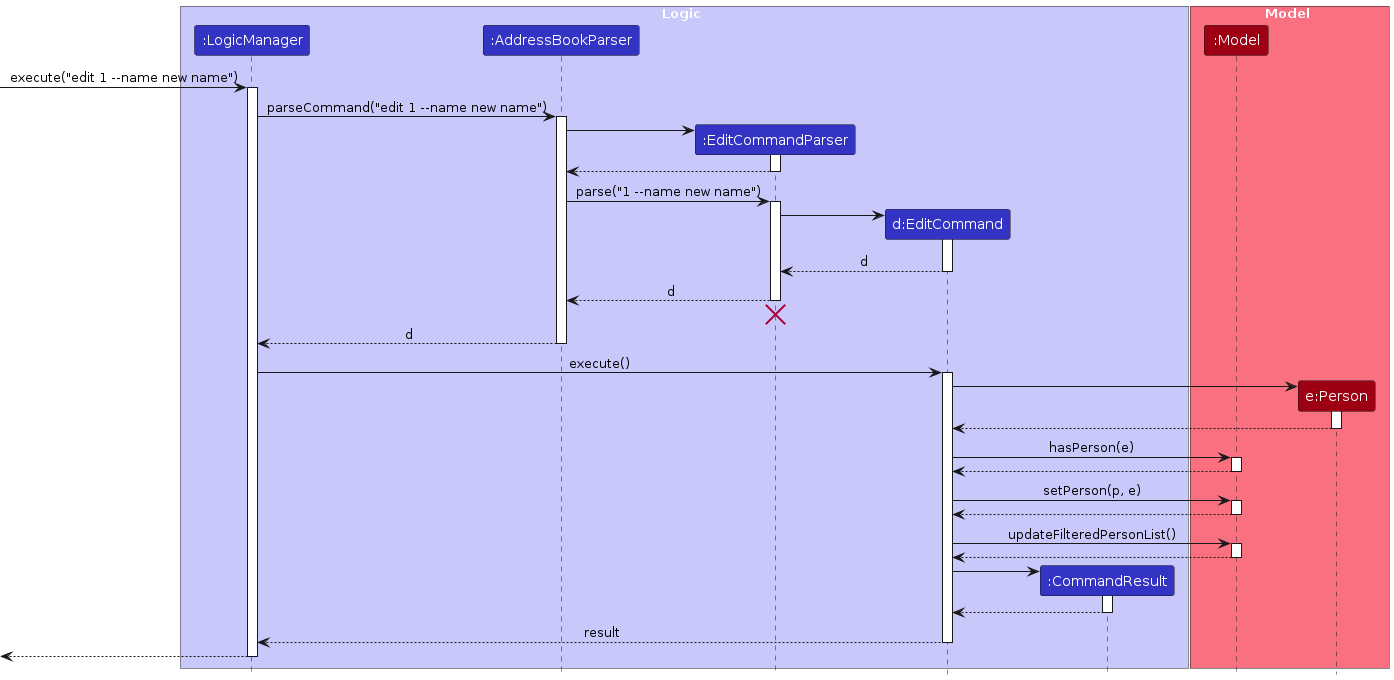
Note
EditCommandParser should end at the destroy marker [X].
Documentation, logging, testing, configuration, dev-ops
Appendix: Requirements
Product scope
Target user profile:
NUS students:
- who wants to consolidate and access profiles of professors, teaching assistants (TAs), and their fellow classmates easily
- who are lazy to navigate to numerous NUS websites for academic resources
- prefer desktop apps over other types
- can type fast
- prefers typing to mouse interactions
- is reasonably comfortable using CLI apps
Value proposition:
- Helps students to consolidate profiles of professors, teaching assistants (TAs), and their fellow classmates, within a single platform
- Compact and easy to navigate
- Students can save time and energy that would otherwise be spent searching for scattered and hard-to-access essential college information
- Features an intuitive and user-friendly interface, making it convenient for users to quickly find the information they need
User stories
Priorities: High (must have) - * * *, Medium (nice to have) - * *, Low (unlikely to have) - *
| Priority | As a … | I want to … | So that I can… |
|---|---|---|---|
* * * | new user | see usage instructions | refer to instructions when I forget how to use the App |
* * * | NUS student | add my classmates, professors and teaching assistants profiles in | easily keep track of my peers and mentors in NUS |
* * * | NUS student | my classmates, professors or teaching assistants profiles | remove entries that I no longer need |
* * * | NUS student | search a profile by name | locate details of a person without having to go through the entire list |
* * | NUS student | view the list of profiles added | |
* | NUS student | favourite profiles I would view often | easily view their profiles when using the app |
* * * | NUS student | close the app when I am done using it | |
* * | NUS student | save my favourite professors, teaching assistants, and classmates in a personal contact list within NUSearch | reach out to them easily in the future |
* * | Professor | include my don’t disturb timings I can reach out to them easily in the future | so that I can have better work life balance |
* * | NUS student | delete my classmates, professors or teaching assistants profiles | I can remove entries I no longer need |
* | NUS student | find the direction to my tutorial / lecture classrooms | I will not get lost on campus. |
Use cases
(For all use cases below, the System is NUSearch and the Actor is the User, unless specified otherwise)
System: NUSearch Use case: UC1 - Add a new profile Actor: User
MSS
- User input a new profile
- NUSearch adds the new profile to the list Use case ends
Extensions
- 1a. NUSearch detects an error in the input data
- 1a1. NUSearch requests for the correct data
- Use case ends
System: NUSearch Use case: UC2 - Asking for help Actor: User MSS
- User requests for help
- NUSearch sends the help
System: NUSearch Use case: UC3 - Asking for List Actor: User MSS
- User requests for the list of profiles
- NUSearch sends the list of profiles
Extensions
- 1a. NUSearch detects no data in the list
- 1a1. NUSearch tells the user the list is empty
- Use case ends
System: NUSearch Use case: UC4 - Exit Actor: User MSS
- User requests for an exit
- NUSSearch exits
System: NUSearch Use case: UC5 - Add favorite Actor: User MSS
- User favorites a profile
- NUSearch favorites the profile
Extensions
- 1b. The profile does not exists
- 1b1. NUSearch tells the user the profile does not exists
- Use case ends
System: NUSearch Use case: UC6 - Search for a profile Actor: User MSS
- User requests for a profile
- NUSearch shows the profile
Extensions
- 1b. The profile does not exists
- 1b1. NUSearch tells the user the profile does not exists
- Use case ends
{More to be added}
Non-Functional Requirements
- Should work on any mainstream OS as long as it has Java
11or above installed. - Should be able to hold up to 1000 persons without a noticeable sluggishness in performance for typical usage.
- A user with above average typing speed for regular English text (i.e. not code, not system admin commands) should be able to accomplish most of the tasks faster using commands than using the mouse.
- The system should store data in a human-editable text file, in a human-readable format.
- The system should work without requiring an installer.
- The system should not depend on a remote server.
- The GUI should not cause any resolution-related inconveniences for a user for standard screen resolutions 1920x1080 or higher.
- The GUI should not cause any resolution-related inconveniences for a user at screen scales 100% or 125%.
- The GUI should be usable at standard screen resolutions 1280x720 or higher.
- The GUI should be usable at screen scale 150%.
- The system should be packaged into a single JAR file.
- The JAR file containing the system should not exceed 100MB in size.
- The system should not take more than 2 seconds to process any given command.
- The GUI should be easy to navigate for an experienced user of the system.
- The system should generally follow the object-oriented paradigm.
- It should be easy to incorporate new commands, attributes or fields into the system.
Glossary
- API: Application Programming Interface, a set of rules and protocols that allow different software applications to communicate with each other
- Architecture Diagram: Visual representation that illustrates how various components of the software project are structured and interconnected
- JavaFX UI: A user interface framework in Java for creating interactive and visually appealing desktop applications
- Mainstream OS: Windows, Linux, Unix, OS-X
- PlantUML: A text-based tool for creating diagrams using simple text descriptions
- Sequence Diagram: A visual tool showing the order of actions between system components or objects
- Object-oriented paradigm:A programming paradigm
- Profile: Information or details of a person, including their name, role, contact details, courses, tutorial classes, etc.
- Manual testing: The process of testing the application through manual execution of specific test cases.
- Logic Component: The component responsible for executing commands and coordinating interactions between different parts of the application.
- Model Component: The part of the application that stores and manages the data, including the address book and user preferences.
- Storage Component: The part of the application that handles reading and writing data.
Appendix: Instructions for manual testing
Given below are instructions to test the app manually.
Note: These instructions only provide a starting point for testers to work on; testers are expected to do more exploratory testing.
Launch and shutdown
Initial launch
Download the jar file and copy into an empty folder
Double-click the jar file Expected: Shows the GUI with a set of sample contacts. The window size may not be optimum.
Saving window preferences
Resize the window to an optimum size. Move the window to a different location. Close the window.
Re-launch the app by double-clicking the jar file.
Expected: The most recent window size and location is retained.
{ more test cases … }
Deleting a person
Deleting a person while all persons are being shown
Prerequisites: List all persons using the
listcommand. Multiple persons in the list.Test case:
delete 1
Expected: First contact is deleted from the list. Details of the deleted contact shown in the status message. Timestamp in the status bar is updated.Test case:
delete 0
Expected: No person is deleted. Error details shown in the status message. Status bar remains the same.Other incorrect delete commands to try:
delete,delete x,...(where x is larger than the list size)
Expected: Similar to previous.
{ more test cases … }
Saving data
Dealing with missing/corrupted data files
- {explain how to simulate a missing/corrupted file, and the expected behavior}
{ more test cases … }